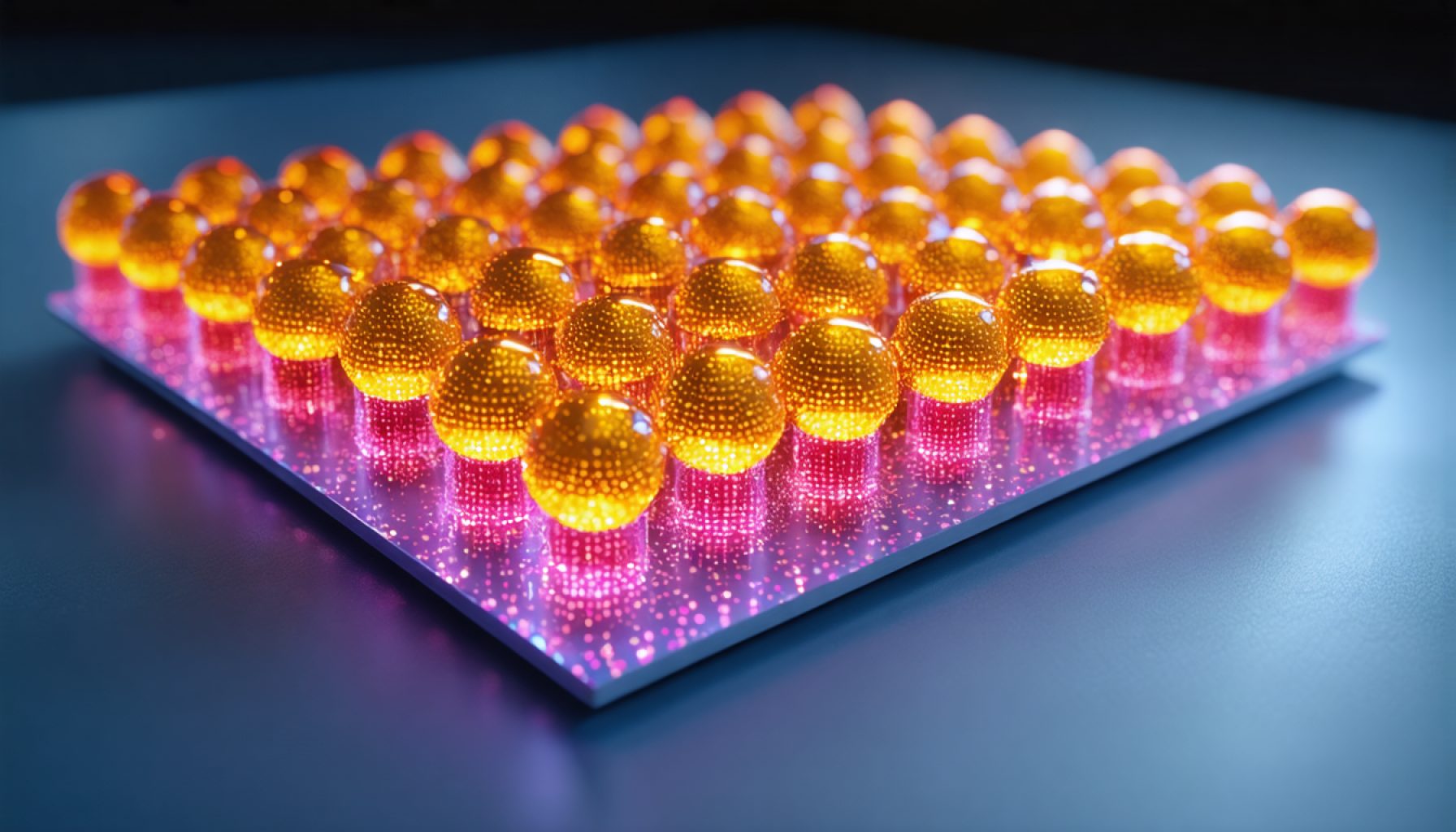- Silicon quantum dots offer eco-friendly alternatives to traditional nanoparticles, boasting abundant availability and a wide photoluminescence range.
- Potential applications include highly efficient solar cells, LEDs, advanced bioimaging, and innovative healthcare solutions.
- Photonic upconversion in these dots can transform low-energy photons into high-energy luminescence, enhancing next-generation solar technology.
- Challenges include low absorption coefficients and defect density, which are being addressed through hybrid systems with organic molecules.
- Silicon quantum dots’ non-toxic nature paves the way for their use in biocompatible materials, offering promising medical applications like oxygen monitoring and phototherapy.
- The continued research and development of silicon quantum dots suggest significant potential to reshape modern technology with environmental consciousness.
Delicate yet robust, silicon quantum dots emerge as brilliant beacons in the expanding realm of photonic technologies. Abandoning the toxicity of traditional chalcogenide nanoparticles, silicon, known for its eco-friendliness, steps into the spotlight. With its abundant nature and rich photoluminescence extending across a wide spectral range, silicon quantum dots promise a revolution.
Imagine solar cells and LEDs shimmering with unprecedented efficiency, or bright artificial tissues guiding biological discoveries. Researchers like Kefu Wang and Ming Lee Tang illuminate the path as they delve deep into the optical wonders of these silicon marvels. It is not merely about harnessing light, but transforming it; a process that photonic upconversion makes stunningly possible. Here, low-energy photons conspire to be reborn as high-energy luminescence, bringing applications in advanced bioimaging and next-generation solar technology tantalizingly within reach.
And yet, perfecting this technology lies in overcoming challenges inherent to silicon’s nature. The low absorption coefficients at visible wavelengths and the sometimes villainous defect density—unseen molecular tangles—pose hurdles not yet scaled. Resolving these issues paves the way for better integration, possibly through hybrid systems pairing silicon with organic molecules, combining absorption prowess with silicon’s stability.
What catches the eye is the promise these silicon dots hold for healthcare—imagining a future where they’re embedded in biocompatible scaffolds to monitor oxygen, or even deployed in phototherapy, given their non-toxic nature. The applications seem limited only by imagination and scientific ingenuity.
As the study of these silicon hybrids expands, the prospects they harbor shine ever more brightly. Harnessing their full potential could reshape facets of modern technology, leaving a legacy intertwining environmental consciousness with scientific excellence. Silicon quantum dots, subdued and silent, whisper of a future luminous with possibilities.
Silicon Quantum Dots: The Future of Eco-Friendly Photonic Innovations
Uncovering the Potential of Silicon Quantum Dots
Silicon quantum dots are poised to revolutionize the field of photonic technologies with their unique combination of eco-friendliness and versatile applications. These nanoparticles shine across a broad spectral range, offering an eco-friendly alternative to traditional chalcogenide nanoparticles, which are known for their toxicity. Let’s delve deeper into the potential uses and the challenges these remarkable particles present.
Real-World Use Cases and Market Potential
1. Enhanced Solar Cells and LEDs: Silicon quantum dots can fundamentally improve the efficiency of solar cells and LEDs. Their ability to photoconvert low-energy photons into high-energy luminescence offers opportunities for more energy-efficient devices. This enhancement could reduce the overall cost of solar energy by producing more power from the same amount of sunlight.
2. Biomedical Advancements: The non-toxic nature of silicon quantum dots makes them ideally suited for medical applications. They can be embedded in biocompatible scaffolds for oxygen monitoring or utilized in phototherapy treatments, offering a safer alternative to current solutions.
3. Advanced Bioimaging: This technology opens doors to enhanced bioimaging techniques due to its unique photoluminescent properties. Silicon quantum dots provide clearer images, enabling more precise diagnostics.
Industry Trends and Market Forecasts
The global market for quantum dots is expected to grow significantly, driven by increased demand for display technologies, solar cells, and bio-medical imaging applications. According to a report by MarketsandMarkets, the quantum dot market size could exceed USD 8 billion by 2030, with a substantial portion driven by innovations in silicon-based materials.
Overcoming Challenges
Despite their advantages, silicon quantum dots face challenges such as low absorption coefficients and high defect density. Researchers are exploring hybrid systems, pairing silicon with organic molecules to leverage silicon’s stability while enhancing absorption capabilities. This could lead to breakthroughs in creating more efficient photonic devices.
How-To Steps: Integrating Silicon Quantum Dots in Photonic Devices
1. Material Preparation: Source high-purity silicon and control its dimensions at the nanoscale to optimize photoluminescence.
2. Address Defects: Utilize surface passivation techniques to reduce defect densities, thus enhancing performance.
3. Combine with Hybrids: Experiment with hybridization, integrating organic molecules to improve absorption properties.
4. Prototype and Test: Construct prototype devices, rigorously testing them across various applications to benchmark performance enhancements.
Pros & Cons of Silicon Quantum Dots
Pros:
– Eco-friendly and non-toxic
– Broad spectral range
– Potentially high efficiency in photonic applications
Cons:
– Low absorption coefficient
– Sensitive to defects
Security, Sustainability, and Environmental Impact
Silicon is abundant and environmentally benign, offering a sustainable alternative to traditional photonic materials. Its non-toxic nature ensures safety in both environmental and healthcare applications, reducing potential risk factors associated with other materials.
Actionable Recommendations
– For Researchers: Focus on developing hybrid systems to increase absorption efficiencies.
– For Industry Professionals: Invest in silicon-based technologies for sustainable growth.
– For Policymakers: Support initiatives fostering eco-friendly photonic technologies to meet future energy demands.
For further insights into the broader implications of quantum dots, visit IDS Corporation.
Silicon quantum dots have the potential to reshape modern technology, harmonizing environmental sustainability with cutting-edge scientific innovation. Their journey from the lab to real-world applications promises to be as transformative as it is exciting.
